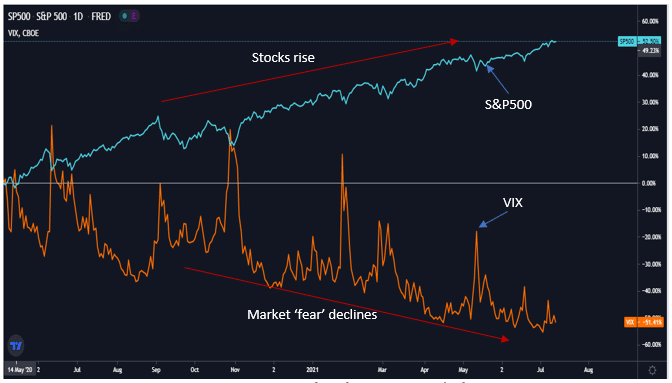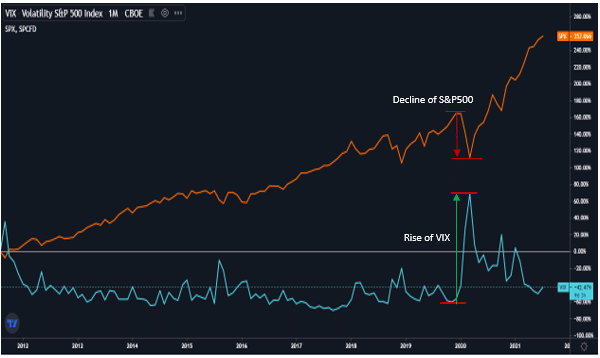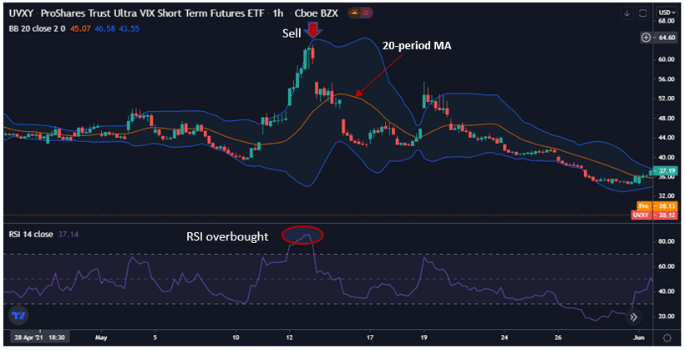Both the forex and the stock market have specific volatility levels, which creates high peaks and lows. But this volatility is not solely a product of technical factors but has more to do with market outlook, more importantly, the sentiment of professional and prominent investors.
But unlike in FX, this type of market volatility is not lagging but indicates future movement. And investors have always been fascinated about how to trade it since it can be highly profitable.
Luckily, the Chicago Board Options Exchange (CBOE) came up with this volatility measurement and updated its methodology to determine it accurately.
This article will detail what volatility is, the VIX indicator, and how to trade it effectively.
What is volatility
Before exploring the meaning of the VIX, the volatility index, let’s understand what volatility is in financial terms.
It refers to the fluctuation from the average price of a tradeable asset measured over a certain period. It is statistically measured by either using the standard deviation or variance between returns.
The more significant the fluctuation, the higher the volatility, and the lower the fluctuation, the lower the volatility.
What is the VIX index?
The VIX is formally known as the Chicago Board Options Exchange (CBOE) Volatility Index, and it measures the fluctuations of price in the S&P 500 over 12 months. It was created in 1993 and initially calculated as a weighted value of the indirect volatility of the S&P 100.
With the evolution of the markets, in 2003, the CBOE and Goldman Sachs combined forces and made improvements to the computation method of the index. They included more options from the S&P 500, representing a more extensive data set of investors’ anticipations.
The VIX index is a leading indicator, which means it’s the market’s expectation of the price changes of the S&P 500, and the percentage change is an annualized calculation.
Let’s use an example to explain this.
We assume the current VIX value is at 25%; the 25% is an annualized value. Therefore, we obtain the monthly change in the S&P 500 by dividing it by 12 months (25%/12 = 2.083%). This means that the monthly fluctuation in the S&P 500 can be 2.083% in an up or downward direction.
For this reason, there exists a relationship between the S&P 500 and the VIX. In addition, the S&P 500 tracks the performance of the top 500 stocks. Therefore, you can understand the importance of the VIX to investors who hold significant capital in any of these stocks.
Correlation between the VIX and the S&P 500
We have charted both indices to illustrate the relationship between the VIX and the stock index.

The above chart shows a strong negative correlation between the VIX and the S&P 500. If we look at the trend of both indices, the S&P 500 trended upwards while the VIX’s movement was down. Note that this is a long-term trend and not the intraday movement.
The declining trend means the sentiment is that volatility is lower, and stocks are rising. The relationship between the VIX and S&P 500 is powerful, and a correlation of between -70% to -90% exists between the indices. This correlation is high and shows a negative relationship.

Here is another instance of the relationship; during the Covid-19 peak of April 2020, the VIX rose sharply while the S&P 500 plummeted. An indication of investor’s “fear” in the market.
This negative correlation is why the VIX can be a profitable asset to trade or hedge against a declining stock market. When investors panic due to an unstable economy or like what happened during the pandemic, they would sell off their stocks, resulting in a declining market or a stock market crash. When this happens, we see high peaks in the VIX and low dips in the stock index.
How to trade the VIX?
There are numerous ways to trade the VIX index, and it can now be traded directly through FX as a CFD instrument. In addition, four significant tradable assets track the VIX’s price.
Investors prefer to trade the short-term ETNs and ETFs; these assets mimic the movement of the VIX.
- iPath Series B S&P 500 VIX Short-Term Futures ETN (VXX)
- iPath Series B S&P 500 VIX Mid-Term Futures ETN (VXZ)
- iPath S&P 500 Dynamic VIX ETN (XVZ)
- ProShares Short VIX Short-Term Futures ETF (SVXY)
The following strategy uses the Bollinger Band (BB) (20-period moving average), a volatility indicator, combined with the Relative strength index (RSI) to trade the VIX ProShares Trust short-term Futures ETF.
The qualifying criteria for this setup:
- To take a sell, you have to wait for the candlesticks to touch the upper BB
- Candlestick patterns should show reversal or multiple rejections at higher time frames
- The RSI should be well in the overbought zone > 70%

From our chart above, we can determine the following:
- We zoom down to the 1-hour chart.
- You can see where the red marker is; the candlesticks touched the upper BB.
- In addition, a dragonfly Doji candlestick formed, which is a sign of possible reversal in an uptrend.
- The next step is to check the RSI. So we can see that the RSI is in the overbought zone, above 70%.
- This is, therefore, an excellent indication to open sell orders.
- We take profit at the 20-period moving average level.
Pros and cons of the VIX
The VIX can be an excellent tool to forecast market volatility, but it has its pros and cons to consider.
Pros
- It is a reliable indicator of investors’ sentiment and can serve as a preventive tool.
- Trading VIX options allow you to take advantage when the market volatility is high.
- Monitoring the VIX performance and combining technical and fundamental factors will give you an edge when trading the S&P 500.
- The VIX forecast enables you to hedge your investments to minimize risks during high volatility.
Cons
- The daily analysis is not sufficient for future insight and is not helpful to make day-trading decisions.
- Trading the VIX comes with high risk, as it does with volatility instruments.
- VIX derivatives are not always accurately matched to the benchmark price and are, therefore, a high-risk investment when holding long-term positions.
Final thoughts
There is no doubt the VIX is a powerful tool to assess future market trends, as it gives a view on the level of “fear” present in the market. These tools are becoming more critical to investors who need to make crucial decisions regarding their portfolios, especially during uncertain economic times. In addition, trading VIX derivatives can be a way to hedge your holdings against stocks that are not performing well.




